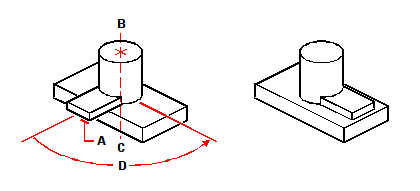Moving and rotating in three dimensions
Moving and rotating in three dimensions
Use the 3D Positioner command to move and rotate entities interactively in three dimensional space.
A visual aid, or gizmo, displays. Click one of its arrows to move entities along the corresponding x, y, or z-axis, or click one of its orbits to rotate entities relative to the corresponding axis. Movement is restricted to the axis you select.
To move or rotate entities in three dimensions
1 Do one of the following to choose 3D Positioner ( ):
):
On the ribbon, choose Home > 3D Positioner (in Modify); Edit > 3D Positioner (in Modify).
On the menu, choose Modify > 3D Operations > 3D Positioner.
On the Modify toolbar, click the 3D Positioner tool.
Type 3dpositioner and then press Enter.
2 Select the entities you want to move or rotate, and then press Enter.
3 Specify a point relative to which the selected entities are moved or rotated.
4 To move selected entities, click the arrow that corresponds to the axis you want to move along. To rotate selected entities, click the orbit that corresponds to the axis you want to rotate around.
5 Specify a new location.
Another way to rotate entities about a specified axis in three dimensional space is using the 3D Rotate command. First you select the entities to rotate and then define the axis of rotation either by specifying two points; selecting an existing entity; aligning the axis with the x-, y-, or z-axis of the current UCS; or aligning the axis with the current view.
To rotate an entity in three dimensions using the 3D Rotate command
1 Do one of the following to choose 3D Rotate ( ):
):
On the ribbon, choose Edit > 3D Rotate (in Modify).
On the menu, choose Modify > 3D Rotate.
On the Modify toolbar, click the 3D Rotate tool.
Type rotate3D and then press Enter.
2 Select the entities to rotate, and then press Enter.
3 Choose from one of the following options: Entity, Last, View, Xaxis, Yaxis, Zaxis.
4 Specify the rotation angle.
5 Specify the reference angle.
|
|
||
|
Select the entities to rotate (A), specify the endpoints of the axis of rotation (B and C), and then specify the rotation angle (D). |
|
Result after rotating the entities. |

 en
en italiano
italiano čeština
čeština Deutsch
Deutsch français
français hrvatski
hrvatski magyar
magyar polski
polski српски
српски русский
русский 中文
中文 中文
中文 한국어
한국어 español
español